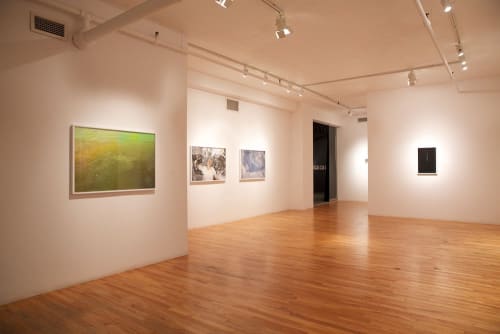Pierre-François Ouellette art contemporain is pleased to present a solo exhibition of new photographs by Chih-Chien Wang since his exhibition at the Montreal Museum of Fine Arts in 2013. The artist's thoughtful approach to documenting life is continued here with an ensemble that presents his experiences with the passing of time and the distance between his origin and the direction of present life.
“We were biking in a park. The path was long, and the sun was shining, and after 30 or 60 minutes following the shade of the trees, we got lost. It was not that we lost our way, but that we lost our perception to the complexity of trees and the sky. We were lost because of the warmth of the sun, the greens of the trees, the white and blue of the sky, and the long wait that a winter seemed would have never ended, while suddenly summer arrived. We were lost because somehow life revealed itself to us and dominated us within its endless and unpredictable power. So, we lay under the bright sun and the trees. Being part of nature but with the outfit of civilization, we were eager to embrace what we were, and where we were from, and at the same time to feel lost in the insignificance of the present. We were longing for an origin, which might not be a country or a land, but a sea. For how far and how long we have been away from it - the sea, where life began.
Taiwan is surrounded by sea. Whenever my 5 year-old son Shaore asked me how we get there, I have always responded “by airplanes”. The sea is a a barrier separating us from the piece of land we came from, not a carrier to bring us home. When we think of the concept of returning, it resides in the process of becoming: we are not going back, but we are becoming the land itself, defining our position as we hold each other’s hands, and looking into each other’s eyes as we search for traces of our life. We are a unit, and we are inseparable. One’s longing becomes the other’s longing, and one’s pain becomes the other’s pain.
The work presented in this exhibition derives from the personal approaches of understanding the relation with nature and with family members while examining the construction of perception. Photography as the main medium is to experiment with the observation of quotidian experience, but it also serves as a failed attempt to grasp what might be seen but not yet captured. This body of works aims at pursuing the absence of origin and embrace the process of becoming.
The work consists of three bodies of images: Sun Father Son, A Photo of Summer and Little Gestures. They work around a vague yet consistent intent of understanding one’s current position in relation to nature, to surroundings, to space, to origin, and to close family members. Instead of being rational this research is following a flow of unpredictable and subjective experiences. Repetition of gestures and examination of perception take important roles in the process while the surface of materials and the use of media form part of the narrative.
The shared interests in the three series link each other to form the work in Distance to the Sea. Photography is a medium to examine the surface of the past in dialogue with the present, while multiple perceptions are formed in a way not to provide a fixed point of view but to propose a sense of losing orientation. The work proposes a process of rooting in the land, even if we are longing for the sea.”
- Chih-Chien Wang
--
Born in Taiwan, Chih-Chien Wang lives and works in Montréal. He obtained a MFA in Studio Arts from Concordia University in 2006 having previously completed a BFA in Theatre and Cinema from the Chinese Culture University in Taipei in 1994. Canadian and International museums and artist-run centres have exhibited his work, including the Montreal Museum of Fine Arts (solo, 2013), the National Gallery of Canada (for the Canadian Biennale "It is what is"), Optica, Dazibao, the Musée d'art contemporain de Montréal (for the Québec Triennial in 2008), the 5th edition of Orange in Ste-Hyacinthe, at Gallery 44 and Nuit Blanche in Toronto, at Zenith Gallery in Beijing and at the Musée de l'Élysée in Switzerland.
His works figure prominently in several public collections including the National Gallery of Canada, Musée de l'Elysée in Lausanne, Musée national des beaux-arts du Québec, Musée d'art contemporain de Montréal, Montreal Museum of Fine Arts - and in corporate and private collections such as Hydro Quebec, Royal Bank of Canada, TD Bank Group, Fédération des Caisses Desjardins, Banque nationale, Giverny Capital and Caisse de dépôt et placement.

